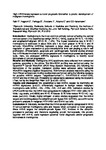High miR-9 levels represent a novel prognostic biomarker to predict development of malignant meningioma
| dc.contributor.author | Baiz, D | |
| dc.contributor.author | Negroni, C | |
| dc.contributor.author | Ferluga, Sara | |
| dc.contributor.author | Ercolano, E | |
| dc.contributor.author | Adams, Claire | |
| dc.contributor.author | Hanemann, Clemens Oliver | |
| dc.date.accessioned | 2018-09-10T13:00:05Z | |
| dc.date.issued | 2018 | |
| dc.identifier.uri | http://hdl.handle.net/10026.1/12316 | |
| dc.description.abstract |
Meningioma is the most common primary tumour affecting the central nervous system; it is classified as benign (WHO I, ~80%), atypical (WHO II, ~15-20%) and anaplastic/malignant (WHO III, ~1-3%). The 3-year recurrence rate in WHO I meningioma is estimated in about 50% and it is much greater in WHO II and III tumours. MicroRNAs (miRNAs) represent a large class of small RNAs driving regulation of gene expression at post-transcriptional level and playing a role in cell proliferation, differentiation, apoptosis and carcinogenesis. Several studies showed that miRNAs are involved in tumour progression and therefore proposed as diagnostic tools. Here, we evaluated miRNAs signature in meningioma to identify novel biomarkers of tumour progression. | |
| dc.language.iso | en | |
| dc.rights | Attribution-NonCommercial-NoDerivatives 4.0 International | |
| dc.rights | Attribution-NonCommercial-NoDerivatives 4.0 International | |
| dc.rights | Attribution-NonCommercial-NoDerivatives 4.0 International | |
| dc.rights | Attribution-NonCommercial-NoDerivatives 4.0 International | |
| dc.rights.uri | http://creativecommons.org/licenses/by-nc-nd/4.0/ | |
| dc.rights.uri | http://creativecommons.org/licenses/by-nc-nd/4.0/ | |
| dc.rights.uri | http://creativecommons.org/licenses/by-nc-nd/4.0/ | |
| dc.rights.uri | http://creativecommons.org/licenses/by-nc-nd/4.0/ | |
| dc.title | High miR-9 levels represent a novel prognostic biomarker to predict development of malignant meningioma | |
| dc.type | conference | |
| dc.type | inproceedings | |
| plymouth.date-start | 2018-06-30 | |
| plymouth.date-finish | 2018-07-03 | |
| plymouth.conference-name | 25th Biennial Congress of the European Association for Cancer Research (EACR25) | |
| plymouth.organisational-group | /Plymouth | |
| plymouth.organisational-group | /Plymouth/Faculty of Health | |
| plymouth.organisational-group | /Plymouth/Faculty of Health/Peninsula Medical School | |
| plymouth.organisational-group | /Plymouth/REF 2021 Researchers by UoA | |
| plymouth.organisational-group | /Plymouth/REF 2021 Researchers by UoA/UoA01 Clinical Medicine | |
| plymouth.organisational-group | /Plymouth/Research Groups | |
| plymouth.organisational-group | /Plymouth/Research Groups/Institute of Translational and Stratified Medicine (ITSMED) | |
| plymouth.organisational-group | /Plymouth/Research Groups/Institute of Translational and Stratified Medicine (ITSMED)/CBR | |
| plymouth.organisational-group | /Plymouth/Users by role | |
| plymouth.organisational-group | /Plymouth/Users by role/Academics | |
| plymouth.organisational-group | /Plymouth/Users by role/Researchers in ResearchFish submission | |
| dc.publisher.place | Amsterdam | |
| dcterms.dateAccepted | 2018-01-01 | |
| dc.rights.embargodate | 2023-7-19 | |
| dc.rights.embargoperiod | Not known | |
| rioxxterms.licenseref.uri | http://creativecommons.org/licenses/by-nc-nd/4.0/ | |
| rioxxterms.type | Conference Paper/Proceeding/Abstract |



